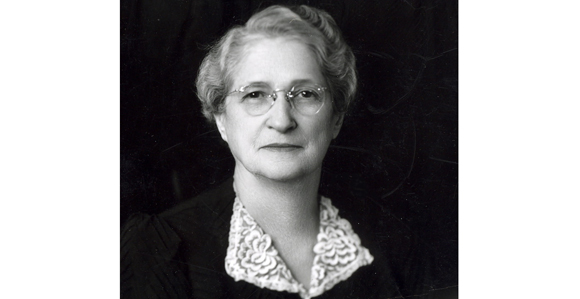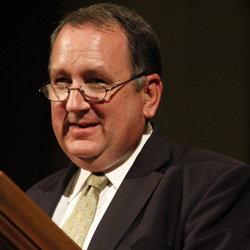Amy Brown Lyman Furthered Social Work of the Church
Contributed By By R. Scott Lloyd, Church News staff writer

Amy Brown Lyman, who assisted in the early 20th-century development of Relief Society, also pioneered its adaptation in the diverse nations of Europe, where her husband presided over the European Mission.
Article Highlights
- Amy Brown Lyman was the subject of a Women of Faith lecture by David Hall, who authored a book about Lyman.
- Sister Lyman recognized the necessity of adjusting programs and policies of the Church to meet the needs of members in diverse political and cultural settings.
- She helped bring modern social work techniques to the service of Church charity.
“Sister Lyman arrived in Europe as an experienced administrator and innovative leader in the affairs of the Relief Society, the Church, and the cause of women.”
—David Hall, biographer
Amy Brown Lyman was first counselor in the Relief Society general presidency in 1936 at the time her husband, Elder Richard R. Lyman of the Quorum of the Twelve, was called as president of the Church’s European Mission. This placed her in a strategic position pertaining to global adaptation of the Church’s women’s organization.
“[Sister] Lyman’s time in Europe thus represents a small but important step along the pathway of recognizing the necessity of adjusting programs and policies to the Church to the needs of members in diverse political and cultural settings,” said David Hall, the speaker August 8 at the monthly Men and Women of Faith Lecture Series sponsored by the Church History Library in the Assembly Hall on Temple Square.
“As Amy stepped off the ship at Plymouth, England, she embarked on a new and challenging period of her career,” said Brother Hall, a lecturer on history at California State University at Fullerton and the author of an upcoming biography on Sister Lyman.
She had been a member of the Relief Society general board for nearly 30 years and its general secretary for 20. “She had been a key player in updating the organization’s agenda and educational curriculum, in particular helping develop its standardized curriculum—which included lessons on literature, theology, and social work—and in the creation of the official publication of the organization, the Relief Society Magazine,” Brother Hall said.
All of that was intended to make the Relief Society more appealing to younger women, and they consequently joined it in droves in the 1910s and 1920s, at a time when membership was voluntary and dues-paying, he noted.
“But it was in the field of social welfare work where perhaps [Sister] Lyman’s greatest achievement took place: that of bringing modern social work techniques to the service of Church charity,” he said.
She had also been involved with the Relief Society’s membership in the National and International Councils of Women.
Thus, Sister Lyman “arrived in Europe as an experienced administrator and innovative leader in the affairs of the Relief Society, the Church, and the cause of women,” Brother Hall remarked.
“But her two years in Europe also confronted her with new realities—and, indeed, a different culture of Mormonism than that to which she was accustomed,” he said. “This eventually led her to rethink the adequacy of the policies and practices that she had helped develop to serve the needs of the majority of women living in communities in the American West. As she came to understand with great clarity, European Saints faced circumstances and challenges very different than their American sisters. An examination of her response to these realities reveals a pattern of adjustments of the kind that would later become more common as Mormonism increasingly established itself beyond its American core.”
The European Mission president had a supervisory role over mission presidents in the different lands of Europe. This brought Sister Lyman into close contact with women of the Church of various nationalities and cultures.
Significant social and economic divisions among members were a challenge, Brother Hall said.

David Hall is a lecturer on history at California State University at Fullerton and the author of an upcoming biography on Sister Lyman. Photo by R. Scott Lloyd.
“Under such circumstances, [Sister] Lyman quickly perceived, for example, that the centralized curriculum developed along the Wasatch Front [in Utah] for Relief Society women was not entirely suitable for European Saints,” he said. That curriculum was “intended to stretch the intellect of American women, who possessed far greater educational opportunities than many of their European sisters. … Amy opined in letters to Relief Society leaders back home that, to many (although certainly not to all) European Saints, the curriculum was simply too advanced.”
This was complicated by the fact that many European sisters were converts with little knowledge of Church doctrine and programs, and the continual exodus of converts to North America in the early days of missionary work had caused a “brain drain” of experienced members, Brother Hall noted.
Sister Lyman “suggested to Relief Society leaders back home that lessons be made simpler, that they focus more on the rudiments of Church doctrine and history and be written in a style that a tired sister could easily comprehend with one reading after a long day of work,” he said.
Regarding charity work, Sister Lyman found ways for Relief Society women in several European countries to contribute meaningfully to the welfare of Church members in ways that did not conflict with established systems, Brother Hall said.
As wife of the European Mission president, Sister Lyman had charge of the other women’s auxiliary organizations in the missions: the YWMIA and the Primary.
While the MIA was doing well in several missions because of the appeal of its wholesome weekday activities, Germany was an exception. “Nazi officials could not comprehend the reasons for Church meetings on days other than Sunday and did not like programs that competed with the agenda of Hitler Youth,” Brother Hall noted.
After the end of Elder and Sister Lyman’s mission, the onset of World War II interrupted the reforms she had instituted. When she became Relief Society general president, she remained sensitive to the challenges faced by the Saints in a war-torn continent.
“While [Sister] Lyman’s own service as Relief Society president ended with her release in the spring of 1945, just as the conflict was winding down, her protégé and successor, Belle Spafford, was there to take up the task of ministering to the scarred and fragmented Relief Societies in the postwar period,” Brother Hall said.
Sister Lyman’s service in Europe “denoted another marker in Mormonism’s passage from a strictly American to an international faith,” he concluded.
